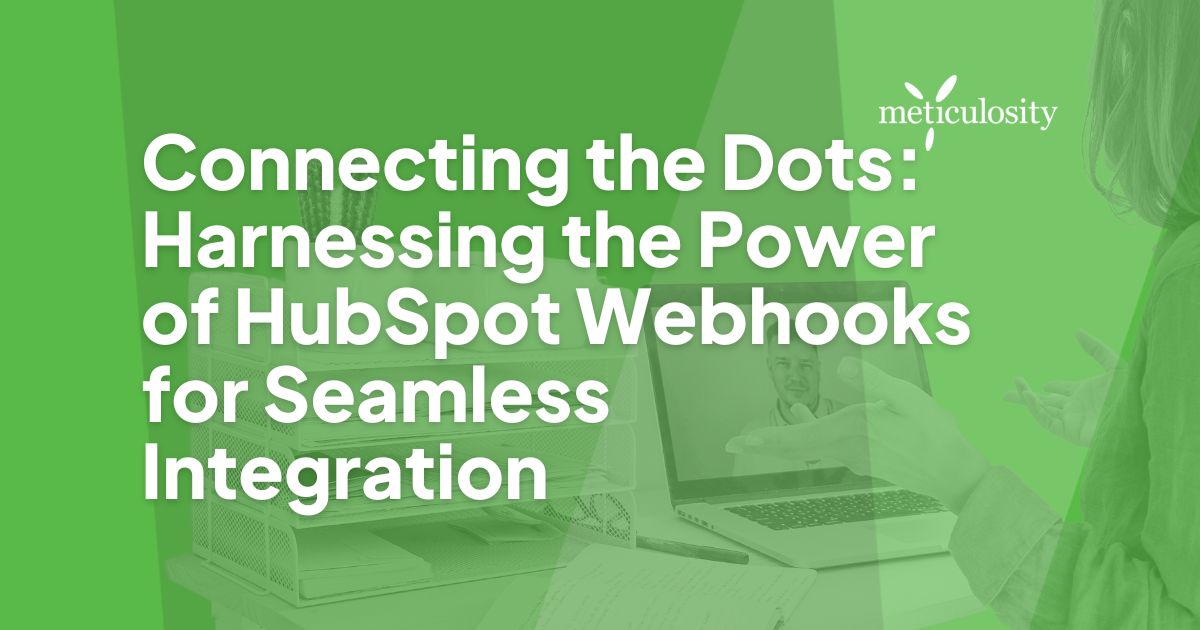Are you tirelessly working to create a smooth connection between all your business processes but hitting one roadblock after another?
In this article, we will delve into how HubSpot’s webhooks feature can automate workflows completely, bridge any integration gaps, and provide instantaneous updates for more insightful decision-making.
Key Takeaways
- Webhooks are a powerful tool for seamless platform integration, providing real-time data updates and automation capabilities.
- HubSpot webhooks offer benefits such as real-time data updates, automation capabilities, and custom reporting and analytics.
- Integrating webhooks with workflows in HubSpot can automate tasks, provide real-time updates on important events, and streamline marketing efforts.
Understanding Webhooks
Webhooks are a powerful tool for seamless platform integration, providing real-time data updates and automation capabilities.
Definition and purpose
Webhooks are a useful tool. They share data between apps right away. When an event happens in one app, it tells another about it. This is their purpose. For example, when someone fills out a form on your website, HubSpot can use a webhook to tell your email app to immediately send them a welcome message.
It's smart and fast!
Advantages over APIs
Webhooks have some clear wins over APIs. With webhooks, you get real-time data. This means the minute something changes, you know about it. No need to keep asking for updates like APIs do.
You save time and resources this way.
Webhooks also give your apps a break because they only send info when there's a change. APIs make your apps work harder by always calling for new data, even if nothing has changed! Webhooks deliver the goods immediately without tearing out your programs or eating into valuable bandwidth.
How to Use Webhooks in HubSpot
To start using webhooks in HubSpot, you can access the HubSpot API and then set up and configure the webhooks according to your needs. Once integrated with workflows, you can leverage the power of webhooks for seamless data integration and automation.
Accessing the HubSpot API
You can get to the HubSpot API with just a few steps. First, sign in to your HubSpot account. Then, look at the top right and find the "Settings" gear. Click and select "Integrations" from the menu on the left side.
Next, choose "API key." Here is where you create a new key or see an old one if you have it already. Check your work before moving ahead! When all looks well, press save. Now, you can use this key with HubSpot Webhooks for easy data sharing!
Setting up and configuring
To set up and configure webhooks in HubSpot, follow these steps:
- Access the HubSpot API: Log in to your HubSpot account and go to the "Integrations" section. From there, navigate to the API settings to get started.
- Create a webhook: Click "Create new integration" or a similar option to set up a new webhook. Fill in the required details, such as the name and URL of your endpoint where you want to receive data.
- Configure webhook settings: Customize your webhook according to your needs. You can choose specific events or triggers to activate the webhook, define the payload format, and set authentication requirements.
- Test your configuration: Before using the webhook in live workflows or automation, test it using tools like Postman or cURL. This ensures that everything is working correctly and that you receive the expected data from HubSpot.
- Integrate with workflows: Once your webhook is set up and tested, integrate it into your workflows or automation processes within HubSpot. Determine which events should trigger actions using webhooks, such as updating contact information or sending notifications.
Integrating with workflows
Integrating your processes with workflows is essential to streamline and make the most out of HubSpot Webhooks. Here's how you can do it:
- Access the HubSpot API: Start by logging into your HubSpot account and navigating to the API settings. This will allow you to connect your webhooks with different workflows.
- Set up and configure: Once you're in the API settings, follow the instructions to set up your webhook integration. Configure the necessary parameters, such as endpoint URL, payload format, and authentication options.
- Customize workflows: Determine which events or triggers should activate your webhooks. For example, you can set up a webhook to be triggered whenever a new contact is added, or a deal reaches a certain stage.
- Test and deploy: Before using webhooks in real-time scenarios, it's crucial to test them thoroughly. Ensure that all endpoints are receiving and processing data correctly. Once everything is working as expected, deploy the webhooks for active usage.
- Monitor and optimize: Regularly monitor your webhook integration for any errors or issues. If there are any problems, troubleshoot them promptly to ensure uninterrupted workflow integration.
Looking to optimize HubSpot for your business? Learn how to improve here.
Benefits of HubSpot Webhooks
HubSpot Webhooks offer numerous benefits, including real-time data updates, automation capabilities, and custom reporting and analytics.
Real-time data updates
Real-time data updates are a key advantage of using HubSpot webhooks. With webhooks, you can receive instant notifications whenever there is new data or changes in your CRM system.
This means that you can stay updated with the latest information without any delay. You can see it right away, whether it's a new lead, an updated contact record, or a completed form submission.
This real-time access to data allows for quicker decision-making and timely follow-ups, which is crucial for effective marketing and sales strategies. By harnessing the power of real-time data updates through HubSpot webhooks, marketers and business professionals can ensure they're always working with accurate and up-to-date information to drive their success.
Automation
Automation is a key benefit of using webhooks in HubSpot. With webhooks, you can automate processes and tasks, making your workflow more efficient and saving time. When an event occurs in HubSpot, such as a new lead being created or a contact updating their information, the webhook will trigger an action to be performed automatically.
This could include sending notifications, updating data in other systems, or executing custom workflows. By setting up these automated actions through webhooks, you can ensure that important tasks are completed promptly and accurately without any manual effort.
Automation simplifies your workload and allows you to focus on more strategic activities for your business growth.
Custom reporting and analytics
Custom reporting and analytics are valuable tools to help marketers and business professionals gain insight into their data and make informed decisions. With HubSpot Webhooks, you can create tailored reports and analyze your data in a way specific to your unique needs.
By leveraging the power of real-time data updates provided by webhooks, you can stay up-to-date with the latest information about your customers, workflows, and campaigns.
With custom reporting, you have complete control over which metrics you want to track and how they are presented. You can choose from various visualizations, such as charts or graphs, to better understand trends and patterns in your data.
This allows you to focus on what matters most to your business objectives.
Regarding analytics, webhooks offer powerful automation capabilities that save time and effort. Instead of manually collecting data from various sources and analyzing them separately, webhooks provide a streamlined solution where relevant information is automatically sent to the right place at the right time.
This enables you to quickly identify opportunities for improvement or areas where adjustments need to be made within your marketing strategies.
Webhook Providers
There are various platform-specific options for webhook providers, each offering their built-in features for seamless integration. Click here to discover the right provider and optimize your HubSpot experience!
Platform-specific options
As a marketer or business professional, you have several platform-specific options for using webhooks in HubSpot. Here is a list of some popular platforms that offer built-in webhook features:
- WordPress: This popular content management system has plugins and integrations that allow you to easily set up webhooks and connect them to your HubSpot account.
- Salesforce: If you use Salesforce as your CRM, you can leverage its webhook functionality to sync data between the two platforms and automate actions based on specific events.
- WooCommerce: For ecommerce businesses using WooCommerce, webhook plugins enable real-time updates between your online store and HubSpot for seamless integration.
- Shopify: Similar to WooCommerce, Shopify also offers webhook functionality through plugins and APIs, allowing you to stay updated with customer data and trigger actions in your HubSpot account.
Built-in webhook features on platforms
We've found that many platforms offer built-in webhook features. These features make it easier to integrate with HubSpot and streamline your processes. Here are some of the benefits you can expect from using these built-in webhook features:
- Simplified setup: With built-in webhook features, you won't have to go through the hassle of setting up webhooks manually. The platform will provide an intuitive interface that guides you through the process.
- Seamless integration: Built-in webhook features ensure smooth integration with HubSpot. This means that you can easily connect your platform with HubSpot without any technical difficulties.
- Time-saving automation: By utilizing these features, you can automate various tasks and workflows in HubSpot. This saves you time and effort by reducing manual work and allowing real-time updates.
- Personalized configuration: Built-in webhook features often allow customization according to your needs. You can configure the webhooks to trigger events based on specific criteria or behaviors, ensuring you receive the most relevant data and notifications.
- Data accuracy: Using built-in webhook features ensures your data is accurate and up-to-date. As soon as an event occurs on your platform, the webhook immediately sends the information to HubSpot, eliminating delays in data synchronization.
- Enhanced reporting and analytics: You can access timely insights and reports in HubSpot with real-time data updates. This enables you to make informed decisions based on the latest information from your platform.
- Improved efficiency: By leveraging these built-in webhook features, you can optimize your workflows and streamline processes within HubSpot. This leads to improved efficiency and productivity for your marketing efforts.

Choosing the Right Webhook Provider
When selecting the perfect webhook provider for your HubSpot integration needs, there are several factors to consider. This section will help you make an informed decision from platform-specific options to built-in webhook features.
Factors to consider
When choosing the right webhook provider for your HubSpot integration, there are several important factors to consider:
- Compatibility: Ensure the webhook provider is compatible with HubSpot's API and can communicate seamlessly with your CRM system.
- Ease of Use: Look for a provider with a user-friendly interface and straightforward setup process. This will save you time and effort in configuring and managing your webhooks.
- Reliability: Check the provider's track record for reliability and uptime. You want to make sure that your webhooks will consistently deliver data without interruptions.
- Scalability: Consider the scalability of the webhook provider, especially if you anticipate high-volume usage or plan to integrate multiple systems with HubSpot.
- Security: Look for providers that offer robust security measures to protect sensitive data transmitted through webhooks. Encryption and authentication protocols should be in place to safeguard your information.
- Support: Choose a provider that offers reliable customer support, including documentation, tutorials, and responsive assistance if you encounter any issues or need guidance during the integration process.
- Cost: Evaluate the pricing structure of different providers to ensure that it aligns with your budget and provides good value for the features and level of service offered.
Comparison of different providers
Selecting the right webhook provider to achieve seamless integration and optimal functionality is essential. The following table provides a comparison of some of the popular webhook providers:
|
Provider |
Real-time data Updates |
Security Features |
Easy Integration |
Cost |
|
HubSpot |
Yes |
High |
Yes |
Varies based on the plan |
|
Slack |
Yes |
Medium |
Yes |
Free up to premium plans |
|
Zapier |
Yes |
High |
Yes |
Varies based on the plan |
|
IFTTT |
No |
Medium |
Yes |
Free up to pro plan |
|
Webhook.site |
Yes |
Low |
Yes |
Free |
|
Integromat |
No |
Medium |
Yes |
Free up to premium plans |
It's important to remember that the right choice for your business will depend on various factors, including your specific needs, budget, and technical proficiency. Take the time to explore your options and make an informed decision.
Best Practices for Using Webhooks in HubSpot
Learn how to properly configure, monitor, and optimize your webhooks in HubSpot for seamless integration and real-time updates. Discover the best practices that will help you harness the power of webhooks and maximize their effectiveness.
Proper configuration
To ensure you get the most out of HubSpot Webhooks, it's important to configure them properly. This involves setting up and fine-tuning your webhook settings to meet your needs.
First, you'll need to access the HubSpot API and generate an API key that will allow you to create webhooks. Once you have your API key, you can start setting up and configuring your webhooks by specifying the events or data changes you want to receive notifications for.
Next, you'll need to define the endpoint for sending these notifications. Typically, this URL represents a specific destination in your system where the webhook payload will be received.
Make sure this endpoint is secure and accessible from outside sources.
Lastly, make sure to customize the payload data that gets sent with each notification. You can choose which fields are included in the payload so that it contains all relevant information for your business processes.
It's also important to consider additional security measures or authentication requirements for accessing this data.
Monitoring and troubleshooting
Let's talk about monitoring and troubleshooting when using webhooks in HubSpot. It's important to monitor your webhook integrations and address any issues that may arise. Here are some tips for effective monitoring and troubleshooting:
- Regularly check the webhook logs: Review the logs to ensure that data is being sent correctly and received by the destination endpoint. Look out for any errors or failed deliveries.
- Use testing environments: Before implementing webhooks in a live environment, test them in a sandbox or staging environment. This allows you to identify and fix potential issues without impacting your production data.
- Monitor error codes: Keep track of any error codes returned by the webhook provider or the destination endpoint. This will help you diagnose and resolve problems more effectively.
- Implement proper error handling: Build in error handling mechanisms that can capture and handle errors gracefully. This could include retrying failed requests, logging errors, or sending notifications for manual intervention.
- Set up alerts and notifications: Configure alerts or notifications to alert you when failures or anomalies are detected in your webhook integrations. This proactive approach allows you to address issues promptly.
- Test with different scenarios: Perform thorough testing with different use cases that simulate real-world scenarios to ensure your webhooks function as expected.
- Stay updated with documentation and support: Keep yourself informed about any updates or changes related to webhooks in HubSpot by regularly referring to their documentation and seeking support when needed.
Optimizing for efficiency
To optimize the efficiency of your webhook integration in HubSpot, you can take a few key steps. First, properly configure your webhooks and set up the necessary triggers and endpoints.
This will ensure that you receive the right data at the right time.
Next, it's important to monitor and troubleshoot any issues that may arise. Regularly check your webhook logs and error messages to identify and address potential problems promptly.
Finally, consider ways to streamline your workflows and minimize unnecessary data transfers. By optimizing your webhook configuration and minimizing the amount of data exchanged between systems, you can improve overall efficiency.

Conclusion
In conclusion, using HubSpot webhooks can significantly enhance your integration capabilities and streamline your workflows. You can achieve seamless connectivity between different platforms and systems by harnessing the power of real-time data updates and automation.
With proper configuration, monitoring, and optimization, webhooks can be a valuable tool for marketers and business professionals looking to maximize the efficiency of their operations.
So, take advantage of this powerful feature in HubSpot to connect the dots and propel your business forward.
Click here to learn more about HubSpot marketing.
FAQs
1. What are HubSpot Webhooks, and how do they enhance integration capabilities?
HubSpot Webhooks are a mechanism that allows your external application or server to receive real-time notifications from HubSpot when specific events occur. This enables you to build more dynamic and responsive integrations by receiving instant updates about changes in data, such as new contacts, deals, or custom events. Webhooks enhance your integration capabilities by providing a timely and efficient way to synchronize data between HubSpot and your external systems.
2. How can I set up and configure Webhooks in HubSpot for integration?
-
Access Webhooks Settings: In your HubSpot account, navigate to "Settings," then to "Integrations," and "API Key."
-
Generate API Key: Create an API key to authenticate your webhook requests and define the specific events you want to be notified about.
-
Create Webhooks: Use the HubSpot API to create webhooks, specifying the endpoint URL where you want to receive notifications.
-
Test and Monitor: Once set up, test your webhooks to ensure they work correctly. HubSpot provides logs and analytics to monitor webhook activity.
Detailed documentation in the HubSpot Developer Documentation provides step-by-step instructions and examples for setting up and configuring webhooks.
3. What types of events can I subscribe to with HubSpot Webhooks?
HubSpot Webhooks allows you to subscribe to various events, ensuring you receive notifications for changes that matter to your integration. Some everyday events include:
-
Contact Created or Updated: Receive notifications when a new contact is added or when existing contact information is updated.
-
Deal Changes: Get real-time updates on deal changes, such as deal stage modifications or new deal creation.
-
Form Submissions: Receive notifications when a form is submitted on your website.
-
Custom Events: Subscribe to custom events you define based on your business processes.
4. How do HubSpot Webhooks ensure data consistency and synchronization between systems?
HubSpot Webhooks play a crucial role in maintaining data consistency and synchronization by providing immediate notifications of changes. This ensures that your external systems are always up-to-date with the latest information from HubSpot. Whether it's a new lead, a deal status update, or any other relevant event, webhooks enable your integration to respond promptly, reducing the risk of data discrepancies between systems.
By leveraging HubSpot Webhooks, you can create more responsive and tightly integrated systems, ensuring your data is accurate and up-to-date across all your platforms.







